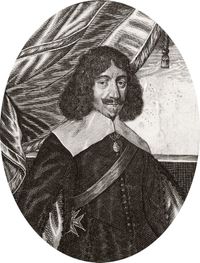
Claude de Mesmes, comte d'Avaux
Encyclopedia

France
The French Republic , The French Republic , The French Republic , (commonly known as France , is a unitary semi-presidential republic in Western Europe with several overseas territories and islands located on other continents and in the Indian, Pacific, and Atlantic oceans. Metropolitan France...
diplomat and public administrator, one of France's leading diplomats in the first half of the century. He was Superintendent of Finances
Superintendent of Finances
The Superintendent of Finances was the name of the minister in charge of finances in France from 1561 to 1661. The position was abolished in 1661 with the downfall of Nicolas Fouquet, and a new position was created, the Controller-General of Finances....
of France from 1649 to 1650.
His first major post was that of a French ambassador to the Republic of Venice
Republic of Venice
The Republic of Venice or Venetian Republic was a state originating from the city of Venice in Northeastern Italy. It existed for over a millennium, from the late 7th century until 1797. It was formally known as the Most Serene Republic of Venice and is often referred to as La Serenissima, in...
(from 1627). Later, Count d'Avaux headed a diplomatic mission
Diplomatic mission
A diplomatic mission is a group of people from one state or an international inter-governmental organisation present in another state to represent the sending state/organisation in the receiving state...
to Denmark
Denmark
Denmark is a Scandinavian country in Northern Europe. The countries of Denmark and Greenland, as well as the Faroe Islands, constitute the Kingdom of Denmark . It is the southernmost of the Nordic countries, southwest of Sweden and south of Norway, and bordered to the south by Germany. Denmark...
and Sweden
Sweden
Sweden , officially the Kingdom of Sweden , is a Nordic country on the Scandinavian Peninsula in Northern Europe. Sweden borders with Norway and Finland and is connected to Denmark by a bridge-tunnel across the Öresund....
in 1634. In 1635, he contributed to the achievement of an armistice between Sweden and the Polish-Lithuanian Commonwealth
Polish-Lithuanian Commonwealth
The Polish–Lithuanian Commonwealth was a dualistic state of Poland and Lithuania ruled by a common monarch. It was the largest and one of the most populous countries of 16th- and 17th‑century Europe with some and a multi-ethnic population of 11 million at its peak in the early 17th century...
in the Treaty of Sztumska Wieś
Treaty of Sztumska Wies
The Treaty of Stuhmsdorf or Sztumska Wieś was a treaty signed on 12 September 1635 between the Polish–Lithuanian Commonwealth and Sweden in the village of Stuhmsdorf , Royal Prussia, just south of Stuhm ....
, where he met many Polish magnate
Magnate
Magnate, from the Late Latin magnas, a great man, itself from Latin magnus 'great', designates a noble or other man in a high social position, by birth, wealth or other qualities...
s (like Rafał Leszczyński). Count d'Avaux concluded treaties between France and Sweden in 1638 and 1641, and during the years 1643–1648, he took part in the lengthy negotiations which led to the Peace of Westphalia
Peace of Westphalia
The Peace of Westphalia was a series of peace treaties signed between May and October of 1648 in Osnabrück and Münster. These treaties ended the Thirty Years' War in the Holy Roman Empire, and the Eighty Years' War between Spain and the Dutch Republic, with Spain formally recognizing the...
, which ended the Thirty Years' War
Thirty Years' War
The Thirty Years' War was fought primarily in what is now Germany, and at various points involved most countries in Europe. It was one of the most destructive conflicts in European history....
. However, d'Avaux was removed from the Congress of Westphalia in 1648, largely due to ideological differences and competition with the other French diplomats and with his superiors in France. Although this affair damaged his reputation, he ended his life serving the French government as a member of the high Council of the Realm.

